Abstract
Not only did Karl May films prove to be the most successful film series in West German history, but they also revived the German film industry. Kölnische Rundschau, a West German newspaper, even headlined its review of Old Shatterhand, the third in the series of Karl May films, with: “Scriptwriter Karl May saves German film.”1 Indianerfilme, the East German response to West German Karl May films, became the most successful movie series in East Germany. Based on the popularity of the Indianerfilme in East Germany, as well as the fact that DEFA created Indianerfilme as a response to the popularity of Karl May Westerns, one might conclude that Karl May’s heroes, Winnetou and Old Shatterhand, not only saved West German cinema, but also contributed to the growth of cinema in East Germany. Furthermore, Karl May films triggered a wave of interest in Westerns across the European continent on a scale previously unknown. Some of them, Italian “Spaghetti” Westerns in particular, became very successful internationally.
Access this chapter
Tax calculation will be finalised at checkout
Purchases are for personal use only
Preview
Unable to display preview. Download preview PDF.
Notes
Michael Petzel. “Deutsche Helden: Karl May im Film”. In Karl May im Film: eine Bilddokumentation. Christian Unucka, ed. Dachau: Vereinigte Verlagsgesellschaften, 1980, 11.
Erwin Mueller, as reported in Helmut Fritz. Roter Bruder Winnetou: Karl May als Erzieher. Eine Sendung zum 150. Geburtstag des Dichters. Siegen, 1992, 20–21. Archiv des Deutschen Filminstituts/Deutschen Filmmuseums. Frankfurt.
Oliver Baumgarten. “Euro-Gunfighter: Karl May und die Deutsche Eurowestern-Erfolgswelle (1962–1968)”. In Um Sie Weht Der Hauch Des Todes: Der Italowestern — die Geschichte eines Genres. Görg Seesslen, Hans Schifferle, and Hans-Christoph Blumenberg, eds. Koeln: Schnitt Verlag, 1999, 15.
Thomas Jeier. Der Western-Film. Muenchen: Wilhelm Verlag, 1995, 189–191.
Tassilo Schneider. “Finding a New Heimat in the Wild West: Karl May and the German Western of the 1960s”. In Journal of Film and Video, Vol. 47, No. 1–3, (Spring–Fall 1995), 54–55.
Erika Kempe-Wiegand. “Die große Mayerei”. In Westdeutsche Allgemeine, Essen, June 1, 1963. Archiv des Deutschen Filminstituts/Deutschen Filmmuseums. Frankfurt.
Joe Hembus. “Wie gut sind die Karl-May-Western? Ein paar nette Wörte für Shatterhand und Winnetou”. Constantin Film Studio. Dokumentation. Microfilm. Archiv des Deutschen Filminstituts/Deutschen Filmmuseums. Frankfurt. Pierre Brice. Mein wahres Leben. Bergisch Gladbach: Gustav Luebbe Verlag, 2004, 10–11 and 240. “Vom Filme über die Bühne zum Hörspiel: Interview mit Chris Howland”. Karl May & Co., Nr. 92, 34. Archiv des Deutschen Filminstituts/Deutschen Filmmuseums. Frankfurt.
Don Shiach. Stewart Granger: The Last of the Swashbucklers. London: Aurum, 2005, 218–219.
Karl Markus Kreis. “German Wild West: Karl May’s Invention of the Definitive Indian”. In I Like America: Fictions of the Wild West. Pamela Kort and Max Hollein, eds. New York: Prestel, 2007, 249–252.
Gerd Gemünden. “Between Karl May and Karl Marx: The DEFA Indianerfilme”. In Germans & Indians: Fantasies, Encounters, and Projections. Colin G. Calloway, Gerd Gemuenden and Suzanne Zantop, eds. Lincoln: University of Nebraska Press, 2002, 244.
Sergio Leone as quoted in Christopher Frayling. Spaghetti Westerns: Cowboys and Europeans from Karl May to Sergio Leone. New York: I.B. Tauris, 2006, 39 and 115.
Peter Martin. “Unser Porträt: Lex Barker”. In West. Allgem., June 30, 1963. Archiv des Deutschen Filminstituts/Deutschen Filmmuseums, Frankfurt.
Hartmut Lutz. “Indianer” und “Native Americans”. Zur social- und literarhistorischen Vermittlung eines Stereotyps. New York: Georg Olms Verlag, 1985, 330–331.
Richard Cracroft. “The American West of Karl May”. In American Quarterly, Vol. 19, No. 2, Part 1 (Summer, 1967), 254.
Marie Versini. Ich war Winnetous Schwester. Bamberg: Karl May Verlag, 2003, 36.
Jeffrey L. Sammons. Ideology, Mimesis, Fantasy: Charles Sealsfield, Friedrich Gerstaecker, Karl May, and Other German Novelists of America. Chapel Hill: University of North Carolina Press, 1998, 105–109 and 239. Ray Allen Billington. Land of Savagery, Land of Promise: The European Image of the American Frontier in the Nineteenth Century. New York: W.W. Norton & Company, 1981, 286.
Maria Höhn and Martin Klimke. A Breath of Freedom: The Civil Rights Struggle, African American GIs, and Germany. New York: Palgrave Macmillan, 2010, 139–141.
Mary Nolan. “American in the German Imagination”. In Transactions, Transgressions, Transformations: American Culture in Western Europe and Japan. Heide Fehrenbach and Uta G. Poiger, eds. New York: Berghahn Books, 2000, 11–12.
J. Boyd Morning Storm. The American Indian Warrior: Native Americans in Modern U.S. Warfare. Manhattan: Sunflower University Press, 2004, xi–xii.
Wolf Schoen. “Wildwest auf deutsch: Ufa-Palast: ‘Der Schatz im Silbersee.’” In Kölnische Rundschau, January 5, 1963. “Die May-Welle des deutschen Films”. In Süddeutsche Zeitung, December 18, 1962. Archiv des Deutschen Filminstituts/Deutschen Filmmuseums. Frankfurt.
“Die May-Welle des deutschen Films”. In Süddeutsche Zeitung, December 18, 1962. Archiv des Deutschen Filminstituts/Deutschen Filmmuseums. Frankfurt. Klaus Hebecker. “Wildwest aus deutscher Hand: Zu Beginn einer Karl-May-Welle: ‘Der Schatz im Silbersee.’” In Hamburger Echo, February 2, 1963. Archiv des Deutschen Filminstituts/Deutschen Filmmuseums. Frankfurt.
Author information
Authors and Affiliations
Copyright information
© 2014 Pawel Goral
About this chapter
Cite this chapter
Goral, P. (2014). German Westerns: Popularity, Reception, Heroines, Miscegenation, Race, and Landscape. In: Cold War Rivalry and the Perception of the American West. Palgrave Macmillan Transnational History Series. Palgrave Macmillan, London. https://doi.org/10.1057/9781137364302_4
Download citation
DOI: https://doi.org/10.1057/9781137364302_4
Publisher Name: Palgrave Macmillan, London
Print ISBN: 978-1-349-47324-3
Online ISBN: 978-1-137-36430-2
eBook Packages: Palgrave History CollectionHistory (R0)

